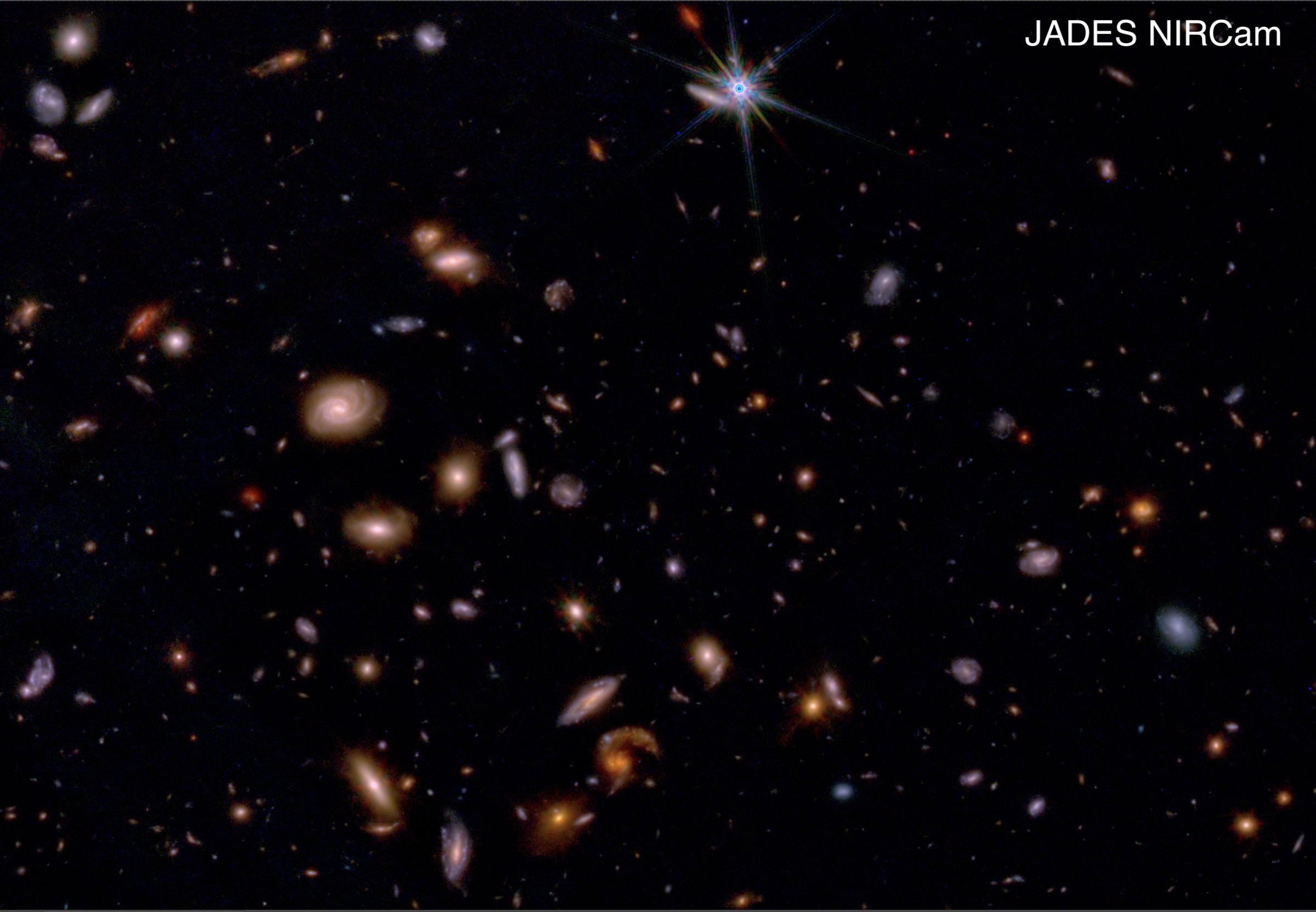James Webb Space Telescope Discovery
Clicking on each image will open the full resolution one. Try it!Clicking on "Raw images" image will yield all the relevant raw images.
Fast-growing galaxy seen by JWST offers window on the early universe
A galaxy seen 700 million years after the big bang appears surprisingly mature, suggesting some pockets of the early universe were more tranquil than expected.
Astronomers using the James Webb Space Telescope (JWST) have found a galaxy in the early universe that appears surprisingly mature, having grown a substantial inner core much more quickly than expected.
 JWST’s view of the galaxy JADES-GS+53.18343-27.79097. NASA, ESA, CSA, JADES Collaboration
The galaxy was found by a JWST survey called JADES, and we see it as it was 700 million years after the big bang. It has a mass of about 400 million times our sun, about 150 times smaller than the Milky Way, and is perhaps 100 million years old.
It had been thought that galaxy formation was fairly tumultuous in the early universe, with protogalaxies crashing together and merging or galaxies rapidly collapsing. But this galaxy seems to be growing in a more sedate manner typical of galaxies in the later universe, with a central core and a surrounding star-forming disc.
Probing how galaxies grew in the early universe, in a period of time known as the Epoch of Reionisation that lasted from 400 million to a billion years after the big bang, has not been possible until now. “We haven’t had good enough imaging,” says William Baker at the University of Cambridge, who led the study. JWST has changed that, finding more distant galaxies than ever seen before.
This galaxy, named JADES-GS+53.18343-27.79097, is small, barely 1500 light-years across, some 70 times smaller than the Milky Way. “It’s pretty compact,” says Baker. But its central core is comparable in mass to modern galaxies, with its outer disc now growing in size at a rate of about eight stars per year, with the galaxy expected to grow to its full size in about 3 billion years.
Christopher Conselice at the University of Manchester, UK, says the discovery suggests galactic structure settled down “earlier than we may have anticipated” in the early universe. “To have something that’s so mature and forming in a way we think galaxies form billions of years later is quite unique,” he says.
That could point to an early universe that was less tumultuous than expected. “Whilst the majority of the universe was probably very violent at this epoch, with mergers and very rapid assembly, I think this shows that there are pockets of the universe where things are calmer than other areas,” says Conselice. “It’s also showing us that galaxy formation is happening much quicker than we thought.”
Credit: Science Hub
JWST’s view of the galaxy JADES-GS+53.18343-27.79097. NASA, ESA, CSA, JADES Collaboration
The galaxy was found by a JWST survey called JADES, and we see it as it was 700 million years after the big bang. It has a mass of about 400 million times our sun, about 150 times smaller than the Milky Way, and is perhaps 100 million years old.
It had been thought that galaxy formation was fairly tumultuous in the early universe, with protogalaxies crashing together and merging or galaxies rapidly collapsing. But this galaxy seems to be growing in a more sedate manner typical of galaxies in the later universe, with a central core and a surrounding star-forming disc.
Probing how galaxies grew in the early universe, in a period of time known as the Epoch of Reionisation that lasted from 400 million to a billion years after the big bang, has not been possible until now. “We haven’t had good enough imaging,” says William Baker at the University of Cambridge, who led the study. JWST has changed that, finding more distant galaxies than ever seen before.
This galaxy, named JADES-GS+53.18343-27.79097, is small, barely 1500 light-years across, some 70 times smaller than the Milky Way. “It’s pretty compact,” says Baker. But its central core is comparable in mass to modern galaxies, with its outer disc now growing in size at a rate of about eight stars per year, with the galaxy expected to grow to its full size in about 3 billion years.
Christopher Conselice at the University of Manchester, UK, says the discovery suggests galactic structure settled down “earlier than we may have anticipated” in the early universe. “To have something that’s so mature and forming in a way we think galaxies form billions of years later is quite unique,” he says.
That could point to an early universe that was less tumultuous than expected. “Whilst the majority of the universe was probably very violent at this epoch, with mergers and very rapid assembly, I think this shows that there are pockets of the universe where things are calmer than other areas,” says Conselice. “It’s also showing us that galaxy formation is happening much quicker than we thought.”
Credit: Science Hub
 More JWST-JADES data (unofficial)
More JWST-JADES data (unofficial)